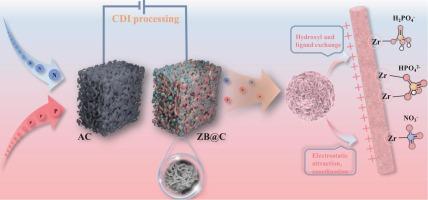Simultaneous capacitive removal of nitrate and phosphate pollutants via Zr-BTB@CNTs electrode for remediation of aquatic eutrophication
IF 9.8
1区 工程技术
Q1 ENGINEERING, CHEMICAL
引用次数: 0
Abstract
The excessive influx of nitrogen and phosphorus, driven by accelerated urbanization, has become a predominant contributor to aquatic eutrophication and water quality deterioration. Herein, Zr-BTB@CNTs (ZB@C), a layered nanoscale metal-organic framework (MOF) material synthesized through a hydrothermal method coupled with carbon nanotubes, was comprehensively evaluated as capacitive deionization (CDI) anode for simultaneous capacitive removal of nitrate (NO3−) and phosphate (PO43−) pollutants from water. The optimized ZB@20C exhibited electrosorption capacities of 222.1 mg g−1 for NO3− and 159.9 mg g−1 for PO43− within 120 min, under an applied voltage of 1.2 V. Furthermore, ZB@20C retained high electrosorption capacities for both nitrate and phosphate across a wide pH range (3−11) and maintained over 80 % removal efficiency for both pollutants after 10 consecutive electrosorption-desorption cycles. Through DFT calculations, XPS, and FTIR analyses, the electrosorption mechanisms of ZB@20C were further elucidated: nitrate electrosorption primarily involves coordination interactions with Zr6 clusters, while phosphate electrosorption mainly stems from lattice oxygen coordination and hydroxyl exchange. Finally, ZB@20C demonstrates strong resistance to ionic interference, effectively reducing nitrate and phosphate concentrations to below 10 mg L−1 and 1.0 mg L−1, respectively, in samples from Chaohu River, Nanfei River, and industrial wastewater, thereby meeting WHO standards.

Zr-BTB@CNTs电极同时电容去除硝酸盐和磷酸盐污染物修复水体富营养化
由于城市化加速,氮和磷的过量流入已成为造成水体富营养化和水质恶化的主要因素。本文综合评价了通过水热法与碳纳米管耦合合成的层状纳米金属有机骨架(MOF)材料Zr-BTB@CNTs (ZB@C)作为电容性去离子(CDI)阳极同时电容性去除水中硝酸盐(NO3−)和磷酸盐(PO43−)污染物的性能。优化后的ZB@20C在1.2 V电压下,对NO3−和PO43−的电吸附量分别为222.1 mg g−1和159.9 mg g−1。此外,ZB@20C在很宽的pH范围内(3 - 11)对硝酸盐和磷酸盐都保持了很高的电吸附能力,并且在连续10次电吸附-解吸循环后,对这两种污染物的去除效率保持在80%以上。通过DFT计算、XPS和FTIR分析,进一步阐明了ZB@20C的电吸附机理:硝酸盐的电吸附主要是与Zr6簇的配位作用,而磷酸盐的电吸附主要是晶格氧配位和羟基交换。最后,ZB@20C对离子干扰具有较强的抵抗能力,能有效地将巢湖河、南淝河和工业废水中的硝酸盐和磷酸盐浓度分别降至10 mg L - 1和1.0 mg L - 1以下,达到WHO标准。
本文章由计算机程序翻译,如有差异,请以英文原文为准。
求助全文
约1分钟内获得全文
求助全文
来源期刊

Desalination
工程技术-工程:化工
CiteScore
14.60
自引率
20.20%
发文量
619
审稿时长
41 days
期刊介绍:
Desalination is a scholarly journal that focuses on the field of desalination materials, processes, and associated technologies. It encompasses a wide range of disciplines and aims to publish exceptional papers in this area.
The journal invites submissions that explicitly revolve around water desalting and its applications to various sources such as seawater, groundwater, and wastewater. It particularly encourages research on diverse desalination methods including thermal, membrane, sorption, and hybrid processes.
By providing a platform for innovative studies, Desalination aims to advance the understanding and development of desalination technologies, promoting sustainable solutions for water scarcity challenges.
 求助内容:
求助内容: 应助结果提醒方式:
应助结果提醒方式:


